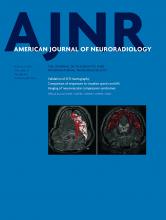Abstract
BACKGROUND AND PURPOSE: Neck musculature mass has been suggested as a biomechanical contributor to injury severity in mild traumatic brain injury. We sought to determine how the cross-sectional areas of the suboccipital muscles affect symptom severity, neurocognitive performance, and recovery time in patients with mild traumatic brain injury.
MATERIALS AND METHODS: Sixty-four consecutive patients with mild traumatic brain injury underwent MR imaging and serial neurocognitive testing with the Immediate Post-Concussion Assessment and Cognitive Test. Cross-sectional areas of the rectus capitis posterior musculature were retrospectively obtained at C1, and cross-sectional areas of the remaining 7 suboccipital muscles were measured at C2. Cross-sectional area reproducibility was evaluated. Overall and individual muscle cross-sectional areas were correlated with symptom severity, neuropsychological testing, recovery time, and headache.
RESULTS: Sixty-four patients with mild traumatic brain injury had imaging through C1, and 43 had imaging through C2. Reproducibility of cross-sectional area measurements was substantial (correlation coefficients = 0.9517–0.9891). Lower cross-sectional area of the rectus capitis posterior minor was correlated with greater symptom severity (r = 0.596, P < .0001), longer recovery time (r = 0.387, P = .002), poor verbal memory performance (r = 0.285, P = .02), and headache (r = 0.39, P = .001). None of the other cross-sectional areas were associated with symptom severity, recovery time, neurocognitive testing, or headache.
CONCLUSIONS: In mild traumatic brain injury, the rectus capitis posterior minor is the only suboccipital muscle whose cross-sectional area is associated with symptom severity and worse outcome. Given the unique connection of this muscle to the dura, this finding may suggest that pathology of the myodural bridge contributes to symptomatology and prognosis in mild traumatic brain injury.
ABBREVIATIONS:
- ΔV
- change in head velocity
- ImPACT
- Immediate Post-Concussion Assessment and Cognitive Test
- mTBI
- mild traumatic brain injury
- rectus capitis-PMaj
- rectus capitis posterior major
- rectus capitis-PMin
- rectus capitis posterior minor
- © 2016 by American Journal of Neuroradiology











